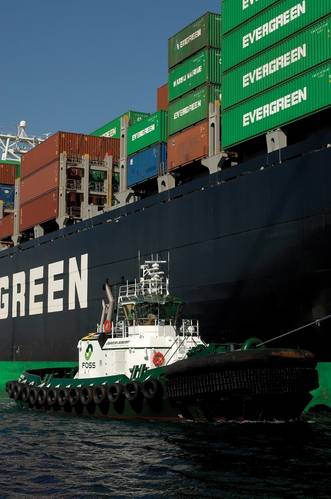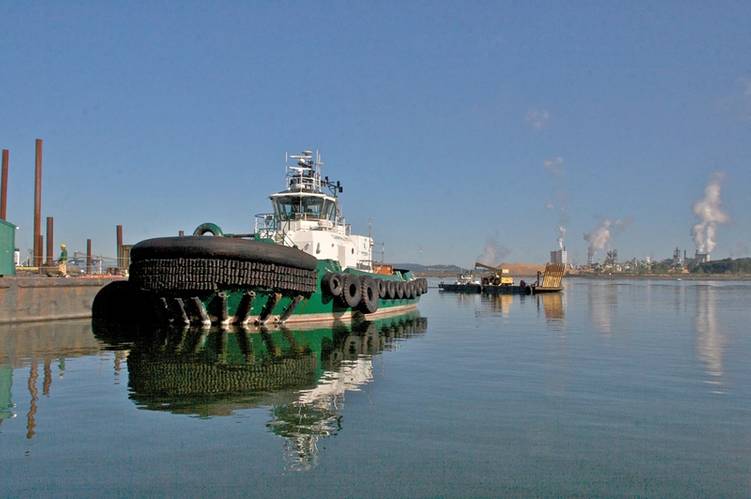Foss: West Coast Icon on Environmental Cutting Edge
Foss Maritime, founded by the matriarch of the Foss family in 1889, is as much a cultural icon on the U.S. West Coast as McAllister or Moran are on the East Coast. Norwegian immigrant Thea Foss began the business when she bought her first row boat in Tacoma, Wash. and painted it the signature green and white.
The Foss family grew the business into a launch service ferrying crew and supplies in the 1910s, then shifted into towing work in the 1940s. Thea Foss is considered the inspiration for Tug Boat Annie, a series of fictional stories by Norman Reilly Raine published in the Saturday Evening Post. The company’s own tug, the Arthur Foss, starred in Tug Boat Annie, the motion picture, in 1933. Schools and waterways in the Seattle/Tacoma area have been named after the Foss family, honoring the impact the business has had on the broader community.
Both Foss family members and vessels played a role in the Second World War, including Henry Foss, a Navy Captain and son to Thea Foss. Henry’s son, Drew Foss was a crew member aboard the tug Justine Foss which was sent to work in the Hawaiian Islands during the war. Drew Foss became a prisoner of war after the tug was taken by the Japanese following the bombing of Pearl Harbor and the capture of Wake Island. In 1969 the family business was sold to a parent company, but Foss family members remained involved in the company leadership until several years ago. In 1987 Foss was again sold, this time to Saltchuk Resources, Inc., which remains Foss’ holding company today. Throughout, Foss has maintained its original green and white colors and the philosophy of innovation that has kept it one step ahead of the market for the last 122 years. Foss Maritime’s current President and CEO, Gary Faber, is a graduate of the U.S. Merchant Marine Academy at Kings Point, N.Y. “It was one thing for the company to remain focused on its values while the members of the Foss family were running the company,” he said. “Now, when there are no Foss family members involved in the company, it takes a special commitment from the entire leadership team and each of our employees to keep the company’s focus on people and the community, and on providing responsive ‘always ready’ service.” No where is Foss Maritime’s innovative spirit and commitment to community more apparent then in its environmental initiatives, including it’s hybrid harbor craft program, its early switch to ultra-low sulfur diesel fuel and its business-wide sustainability goals.
The Foss Hybrid Approach
Foss’ commitment to the environment sets the company apart, Faber said. “Now and in the future, we believe the companies best positioned to compete for work will be those with the best environmental and safety records.” “I am proud of the hybrid technology we have developed and the fact that we are now in the final stages of developing our second hybrid tug, which is a conversion of a conventional tug to hybrid power.” Foss’ second hybrid, the Campbell, is undergoing a hybrid retrofit at the company’s Rainier Shipyard in Rainier, Ore. The Campbell is headed for the Port of Los Angeles/Long Beach, where the first Foss hybrid harbor tug, the Carolyn Dorothy, is also home-ported.
The Carolyn Dorothy is a Dolphin class tug and was built as a hybrid “out of the box,” Faber said. As the pilot hybrid, she was built from scratch, but Foss has nine other conventional Dolphin class tugs, including the Campbell. These are all planned to be retrofitted as hybrids. Foss is currently going through EPA certification for the Carolyn Dorothy. Having the conventional sister tugs has helped compare apples to apples, as far as the true fuel and emissions reductions realized, Faber said. “We’ve met or exceeded the original estimates for emissions reductions and fuel savings on the Carolyn Dorothy,” he confirmed. Operational results from the pilot hybrid show that the main diesel engines have been used just 1% of the time and the generator engines are used 65 to 85% of the time.
Faber said the entire Dolphin class should be retrofitted in five to seven years, “unless demand changes,” in which case “we could do it in three years.” Retrofitting one vessel takes about two months, depending on how it fits in with other projects going on in the yard.
“We look at what every craft does and match the hybrid system to those requirements,” he said. “We know exactly what the duty cycle is, the frequency she spends at what band of power. We work backwards and come up with the right sized generator which drives the propulsion unit in hybrid mode.”
There are three components of the hybrid system: the main engines, the generator engines and the batteries. Having been built from scratch, the Carolyn Dorothy was designed with smaller engines, but the retrofitted tugs will be keeping their larger engines. “The real challenge on the retrofits is finding the extra space for the generator engines and batteries,” Faber said.
Other Technological Alternatives?
“Hybrid technology lends itself to harbor craft with the intermittent cycles,” Faber said. But what about other ways to reduce the carbon footprints of work boats? Faber sees LNG for harbor craft as a “very real near-term opportunity,” although Foss “went down a different path — the hybrid path. It lead us to a larger a reduction, faster.”
“LNG in combination with hybrid might be the ultimate solution,” especially for harbor craft. However, for towing he said, “because of the volume of fuel you would need, I don’t know if it would be viable.”
The intermediate solution for ocean towing continues to be new, efficient diesel engine and propulsion technology, according to Faber. “Diesel technology has improved dramatically in the last five years. It’s been impressive.” Smaller packages deliver the same or more thrust he pointed out, and hull efficiencies further reduce fuel consumption and emissions output. “It’s a huge leap forward,” and the next steps may be alternative fuels or propulsion systems.
Foss also voluntarily switched its entire fleet to ultra-low sulfur diesel in 2007, a year before the California Air Resources Board (CARB) began enforcing the ultra-low sulfur diesel fuel rule in regional waters. “Everywhere we operate, anywhere in the world we can get it, we use ultra-low sulfur diesel,” Faber said.
“Early on we looked at what the effect would be on the engines,” given that sulfur in fuel provides lubrication, but also creates corrosion. Up to this point, he said they’ve found no impact either way, even though it’s still in the experimental phase and it’s too soon to tell.
Ultimately, Faber said, propulsion technology has to be matched to the service the tug is in and the challenge to overcome is that tugs are often in one service today and another tomorrow. But, “over time, we hope to see this hybrid technology — and other green technologies — become industry norms rather than exceptions.”
Integrating Sustainability
“We have developed milestones, some specific and some aspirational, that we believe will result in a sustainable business model and a safer, cleaner working environment.” Faber said. “Environmental stewardship has been and continues to be a core value and a primary business driver. However, we have evolved beyond just environmental stewardship and decided that our vision is to reach a level of ‘Zero Trace’ for our business.”
“Zero Trace” is an aspirational goal to leave no carbon footprint, meaning no detrimental emissions from tugs, equipment or land-based facilities, and no residual trace in landfills after a vessel has been built or decommissioned.
Foss also demonstrated its commitment to sustainability when it appointed Susan Hayman as its Vice President for Environmental and Governmental Affairs. Hayman, who spearheaded the development of the Carolyn Dorothy, is now focused 100% on the company’s environmental initiatives.
“There is a big difference between being environmentally aware and being environmentally proactive,” Faber said. “Companies are defined by what they repeatedly do, without having to be asked.”
(As published in the November 2011 edition of Maritime Reporter & Engineering News - www.marinelink.com)














